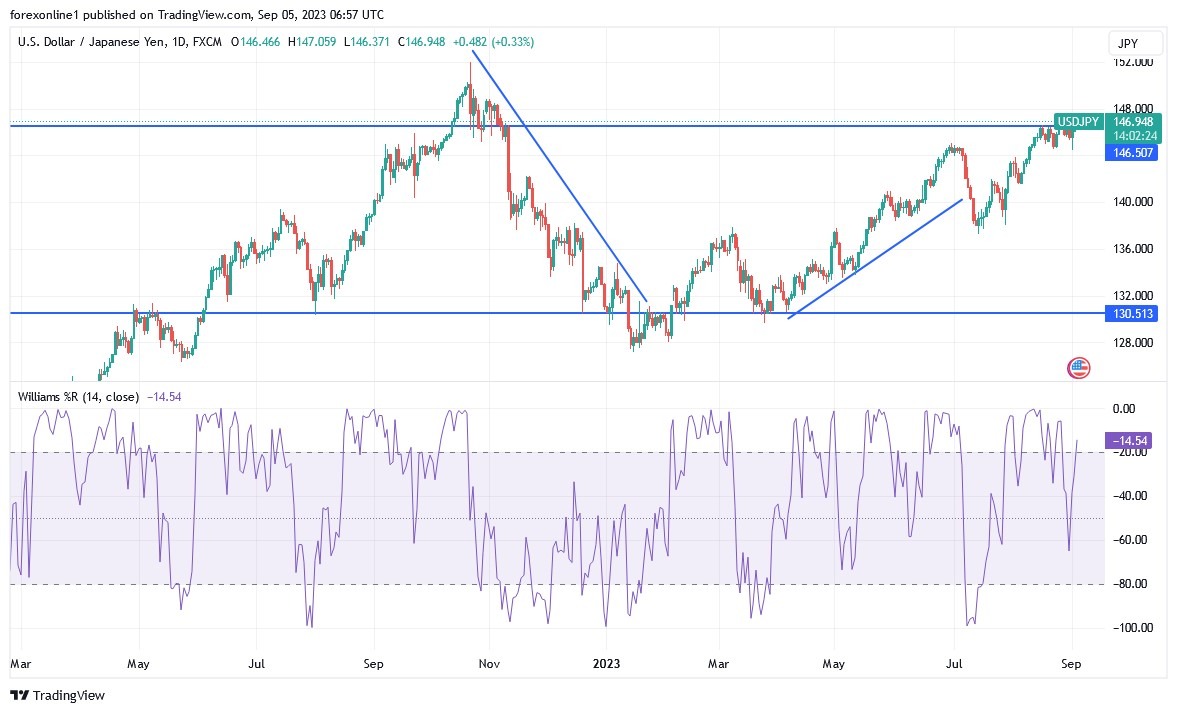The initial market reaction to the US jobs report for the month of August was clear and immediate, with the drop in the US dollar and yields. This did not continue, as the price of the US dollar vs. Japanese yen USD/JPY currency pair bounced back higher with gains extending to the resistance level of 146.50, which is stable around it at the time of writing the analysis. The lowest level recorded by the currency pair last week was the support of 144.44. Until now, the Japanese yen is still the lowest against the rest of the other major currencies in the light of the Bank of Japan's policy of easing with negative interest rates until now.
Top Forex Brokers
Unexpectedly weak US employment report failed to put pressure on the US dollar on Friday. While US non-farm payrolls slightly exceeded expectations in August, revisions showed that employment growth in July and June was much weaker than previously reported. Wage growth also slowed, bolstering market expectations that the Federal Reserve will hold off on raising interest rates this month. The implied probability of a US interest rate hike in September fell to around 7% following the employment data, from around 20% last week.
The initial reaction of the market was clear and explicit, with the decline of the US dollar and yields, but it did not continue. Once the dust settled, long-term Treasury yields rose again, which led to the strength of the US dollar. Overall it's hard to say what was behind this reversal, although higher oil prices and the stronger manufacturing survey from the ISM certainly helped.
Looking ahead, the outlook for the dollar looks increasingly favorable. And the US economy is already in a better position than the eurozone economy, and the recent rise in energy prices may exacerbate this disparity, affecting the euro against the dollar in terms of growth differentials and trade flows. Hence, the only missing ingredient for a broad-based rally in the US dollar may be a period of risk aversion in equity markets.
On the other hand, it seems that a series of stimulus measures directed at China have finally succeeded in restoring some confidence among investors.
Japanese Finance Minister Shunichi Suzuki said on Friday that markets should determine currencies although sudden moves are undesirable, while giving no clear indication of market intervention to support the weak yen, which is driving up import bills. Suzuki added to the reporters sticking to the usual official line: "The currencies must reflect the economic fundamentals... I am watching the currency movements closely."
And "There is no change in my view on currencies since (what) I mentioned earlier. Suzuki added: "There is nothing that can be added."
Some traders in the market were surprised by the lack of determination to prevent the yen from falling further than 145 yen to the dollar. The breakthrough of that level last September was the reason for the first Japanese intervention in buying the yen in 24 years. For her part, Disako Uino, senior foreign exchange market analyst at Mitsubishi UFJ Securities, said: "I was surprised by the lack of enthusiasm in Suzuki's comment." And "this made me think that the Japanese authorities will wait until the dollar reaches its lowest level in 32 years near 152 yen to intervene."
Speculation remains in the forex markets that the Japanese authorities may change their stance on the weak yen by focusing on fiscal policy measures, such as maintaining gasoline subsidies to ease the impact of rising prices on consumers. The authorities also say that the weakness of the Japanese yen helps attract more foreign tourists, which boosts the service sector. The other possibility was that Japan could not win the acceptance of the United States for its intervention in the sale of the dollar.
In general, the performance of the Japanese yen has been weak recently as investors increase bets that the US Federal Reserve may continue to raise US interest rates, or keep interest rates high for a longer period of time as part of its attempt to curb inflation, while the Bank of Japan maintains its highly accommodative policy.
Investors are watching for any signs of intervention by Japanese officials to support the struggling currency. However, Japanese officials have rarely stepped up verbal warnings since last month against speculators trying to sell the yen. At the same time, the weakness of the Japanese yen led to a rise in fuel and food import bills, which deprived families of purchasing power and prompted Japanese Prime Minister Fumio Kishida to expedite measures to support retail gasoline prices and reduce increases in utility bills.
The Bank of Japan remains exceptional among global central banks because of its lenient monetary policy, even as it slowly shifts away from control of the yield curve.
Expectations of the US dollar against the Japanese yen:
- According to the performance on today's chart, the general trend of the USD/JPY currency pair is still upward.
- The trend may remain as long as the contrast continues between the strict policy of the US central bank until the containment of US inflation and the policy of the Japanese central bank, which takes an opposite position with negative interest rates.
- The closest resistance levels to the current performance are 147.20 and 148.00 respectively.
There will not be a strong and real change in direction without Japanese intervention in the markets to prevent further collapse of the Japanese yen price and testing the 142.00 support will represent the first breakthrough of the current upward trend.
Ready to trade our Forex daily forecast? We’ve shortlisted the best currency trading platforms in the industry for you.

